Two-Dimensional Magnetotelluric Parallel-Constrained-Inversion Using Artificial-Fish-Swarm Algorithm
Abstract
1. Introduction
2. Parallel-Forward-Modeling of 2D MT Data
2.1. Basic Approach of Parallel-Forward-Modeling
2.2. Parallel-Forward-Verification and Comparison
3. Constrained Inversion of Artificial-fish-swarm algorithm
3.1. Model Selection
3.2. Preying Behavior
3.3. Swarming Behavior
3.4. Following Behavior
3.5. Objective Function
3.6. The Basic Idea of Parallel Inversion
4. Synthetic-Model Tests
4.1. Quasi-2D Parallel Inversion
4.2. 2D Parallel Inversion
5. Field-Data Results
5.1. Characteristics of Formation Resistivity
5.2. Constrained-Inversion Results
6. Conclusions
- (1)
- the accuracy of FD is comparable to FE; however, the calculation speed is ten times faster than that of FE;
- (2)
- the artificial-fish-swarm-inversion based on paralleling forward can effectively improve the inversion speed. For parallel 2D MT-inversion, the maximum acceleration is 15, by using 20 CPUs;
- (3)
- the proposed inversion-method has good practicability.
Author Contributions
Funding
Institutional Review Board Statement
Informed Consent Statement
Data Availability Statement
Conflicts of Interest
References
- Gallardo, L.A.; Meju, M.A. Characterization of heterogeneous near-surface materials by joint 2D inversion of DC resistivity and seismic data. Geophys. Res. Lett. 2003, 30, 1658–1661. [Google Scholar] [CrossRef]
- Gallardo, L.A.; Meju, M.A. Joint two-dimensional DC resistivity and seismic travel-time inversion with cross-gradients constraints. J. Geophys. Res. 2004, 109, B03311. [Google Scholar] [CrossRef]
- Dell‘Aversana, P.; Colombo, S.; Ciurlo, B.; Leutscher, J.; Seldal, J. CSEM data interpretation constrained by seismic and gravity data: An application in a complex geological setting. First Break 2012, 30, 43–52. [Google Scholar] [CrossRef]
- Shi, Y.-L.; Hu, Z.-Z.; Huang, W.-H.; Wei, Q.; Zhang, S.; Meng, C.-X.; Ji, L.-S. The distribution of deep source rocks in the GS Sag: Joint MT–gravity modeling and constrained inversion. Appl. Geophys. 2016, 13, 469–479. [Google Scholar] [CrossRef]
- Meju, M.A.; Saleh, A.S.; Mackie, R.L.; Miorelli, F.; Miller, R.V.; Mansor, N.K.S. Workflow for improvement of 3D anisotropic CSEM resistivity inversion and integration with seismic using cross-gradient constraint to reduce exploration risk in a complex fold-thrust belt in offshore northwest Borneo. Interpretation 2018, 6, SG49–SG57. [Google Scholar] [CrossRef]
- Dong, Y.; Cheng, J.; Xue, J.; Wen, L.; Chen, T.; Wang, H.; Chen, Z.; Tian, C. Research on pseudo-2D joint inversion of TEM and CSAMT based on well log constraint. J. Environ. Eng. Geophys. 2021, 26, 61–70. [Google Scholar]
- Liu, Y.; Liu, J.; Chen, C.; Wang, G.; Liao, Q.; Zhang, X. The application of audio magnetotelluric for 3D geological mapping in the Gobi Desert area. Geol. J. 2020, 55, 7335–7345. [Google Scholar] [CrossRef]
- Sun, H.; Liu, Y.; Wang, Z.; Wang, Z.; Liu, J.; Chcn, C.; Wang, G.; Wang, A. Constrained inversion of audio magnetotelluric for identifying strata: A case study in Hami basin. Earth Sci. 2022, 47, 4280–4293. [Google Scholar]
- Hu, W.Y.; Abubakar, A.; Habashy, T.M. Joint electromagnetic and seismic inversion using structural constraints. Geophysics 2009, 74, R99–R109. [Google Scholar] [CrossRef]
- Gao, G.; Abubakar, A.; Habashy, T.M. Joint petrophysical inversion of electromagnetic and full-waveform seismic data. Geophysics 2012, 77, WA3–WA18. [Google Scholar] [CrossRef]
- McMillan, M.S.; Oldenburg, D.W. Cooperative constrained inversion of multiple electromagnetic data sets. Geophysics 2014, 79, B173–B185. [Google Scholar] [CrossRef]
- Xu, K.J.; Li, Y.G. Constraining magnetic amplitude inversion with magnetotelluric data to image volcanic units: A case study. Geophysics 2020, 85, B63–B75. [Google Scholar] [CrossRef]
- Ogarko, V.; Giraud, J.; Martin, R.; Jessell, M. Disjoint interval bound constraints using the alternating direction method of multipliers for geologically constrained inversion: Application to gravity data. Geophysics 2021, 86, G1–G11. [Google Scholar] [CrossRef]
- Brown, V.; Singh, S. Using seismic full waveform inversion to constrain controlled-source electromagnetic inversion. In Proceedings of the 80th Annual International Meeting, SEG, Expanded Abstracts, Denver, CO, USA, 17–22 October 2010; pp. 619–623. [Google Scholar]
- da Silva, N.V.; Morgan, J.; Warner, M.; Umpleby, A.; Stekl, I. 3D constrained inversion of CSEM data with acoustic velocity using full waveform inversion. In Proceedings of the 82nd Annual International Meeting, SEG, Expanded Abstracts, Las Vegas, NV, USA, 4–9 November 2012; pp. 1–5. [Google Scholar]
- Hu, Z.Z.; He, Z.X.; Wang, Y.T.; Sun, W. Constrained inversion of magnetotelluric data using parallel simulated annealing algorithm and its application. In Proceedings of the 2010 SEG Annual Meeting, Denver, CO, USA, 17–22 October 2010; pp. 895–899. [Google Scholar]
- Zhou, L.F.; Tan, H.D. Two-dimensional joint inversion of magnetotelluric and seismic data with cross gradient constraints. In Proceedings of the 10th China International Geo-electromagnetic Induction Workshop, Nanchang, China, 13–14 October 2011; pp. 253–255. [Google Scholar]
- Hu, Z.Z.; He, Z.X.; Yang, W.C.; Hu, X.Y. Constrained inversion of magnetotelluric data with theartificial fish swarm optimization method. Chin. J. Geophys. 2015, 58, 2578–2587. [Google Scholar]
- Li, S.-C.; Nie, L.-C.; Liu, B.; Song, J.; Liu, Z.-Y.; Su, M.-X.; Xu, L. 3D electrical resistivity inversion using prior spatial shape constraints. Appl. Geophys. 2013, 10, 361–372. [Google Scholar] [CrossRef]
- Bergmann, P.; Ivandic, M.; Norden, B.; Rucker, C.; Kiessling, D.; Luth, S.; Schmidthattenberger, C.; Juhlin, C. Combination of seismic reflection and constrained resistivity inversion with an application to 4D imaging of the CO2 storage site, Ketzin, Germany. Geophysics 2014, 79, B37–B50. [Google Scholar] [CrossRef]
- Shi, Y.L.; Huang, W.H.; Wei, Q.; Hu, Z.Z. Deep rift identification with MT inversion constrained by shallow logging and seismic data. Oil Geophys. Prospect. 2016, 51, 1233–1240. [Google Scholar]
- Chen, X.; Deng, J.; Ge, K.; Wang, Y.; Zhang, H.; Yu, P. A new framework for geophysical joint inversion. Oil Geophys. Prospect. 2017, 52, 851–858. [Google Scholar]
- Constable, C.S.; Parker, R.L.; Constable, C.G. Occam’s inversion:Apractical algorithm for generating smooth models from electromagnetic sounding data. Geophysics 1987, 52, 289–300. [Google Scholar] [CrossRef]
- deGroot-Hedlin, C.; Constable, S. Occam’s inversion to generate smooth, two-dimensional models from magnetotelluric data. Geophysics 1990, 55, 1613–1624. [Google Scholar] [CrossRef]
- Siripunvaraporn, W.; Egbert, G. An efficient data-subspace inversion method for 2-D magnetotelluric data. Geophysics 2000, 65, 791–803. [Google Scholar] [CrossRef]
- Rodi, W.; Mackie, R.L. Nonlinear conjugate gradients algorithm for 2-D magnetotelluric inversion. Geophysics 2001, 66, 174–187. [Google Scholar] [CrossRef]
- Coggon, J.H. Electromagnetic and electrical modeling by the finite element method. Geophysics 1971, 36, 132–155. [Google Scholar] [CrossRef]
- Key, K.; Weiss, C. Adaptive finite-element modeling using unstructured grids: The 2D magnetotelluric example. Geophysics 2006, 71, G291–G299. [Google Scholar] [CrossRef]
- Wannamaker, P.E.; Stodt, J.A.; Rijo, L. Two dimensional topographic responses in magnetotellurics modeled using finite elements. Geophysics 1986, 51, 2131–2144. [Google Scholar] [CrossRef]
- Wannamaker, P.E.; Stodt, J.A.; Rijo, L. A stable finite element solution for two-dimensional magnetotelluric modelling. Geophys. J. Int. 1987, 88, 277–296. [Google Scholar] [CrossRef]
- Smith, J.T.; Booker, J.R. Rapid inversion of two- and three-dimensional magnetotelluric data. J. Geophys. Res. 1991, 96, 3905–3922. [Google Scholar] [CrossRef]
- Mackie, R.L.; Madden, T.R.; Wannamaker, P.W. Threedimensional magnetotelluric modeling using difference equations-Theory and solutions. Geophysics 1993, 58, 215–226. [Google Scholar] [CrossRef]
- Mackie, R.L.; Smith, J.T.; Madden, T.R. Three-dimensional electromagnetic modeling using finite difference equations: The magnetotelluric example. Radio Sci. 1994, 29, 923–935. [Google Scholar] [CrossRef]
- Newman, G.A.; Alumbaugh, D.L. Frequency-domain modeling of airborne electromagnetic responses using staggered finite differences. Geophys. Prospect. 1995, 43, 1021–1042. [Google Scholar] [CrossRef]
- Shi, M.J.; Xu, S.Z.; Liu, B. Finite element method using quadratic element in MT forward modeling. Chin. J. Geophys. 1997, 40, 421–430. [Google Scholar]
- Siripunvaraporn, W.; Egbert, G.; Lenbury, Y. Numerical accuracy of magnetotelluric modeling: A comparison of finite difference approximation. Earth Planets Space 2002, 54, 721–725. [Google Scholar] [CrossRef]
- Mehanee, S.; Zhdanov, M. A quasi-analytical boundary condition for three-dimensional finite difference electromagnetic modeling. Radio Sci. 2004, 39, RS6014. [Google Scholar] [CrossRef]
- Mitsuhata, Y.; Uchida, T. 3D magnetotelluric modeling using the T-Ω finite-element method. Geophysics 2004, 69, 108–119. [Google Scholar] [CrossRef]
- deGroot-Hedlin, C. Finite-difference modeling of magnetotelluric fields: Error estimates for uniform and nonuniform grids. Geophysics 2006, 71, G97–G106. [Google Scholar] [CrossRef]
- Li, Y.; Pek, J. Adaptive finite element modelling of two-dimensional magnetotelluric fields in general anisotropic media. Geophys. J. Int. 2008, 175, 942–954. [Google Scholar] [CrossRef]
- Zhdanov, M.S. Inverse Theory and Applications in Geophysics; Elsevier: Amsterdam, The Netherlands, 2015. [Google Scholar]
- Lin, C.H.; Tan, H.D.; Tong, T. Parallel rapid relaxation inversion of 3D magnetotelluric data. Appl. Geophys. 2009, 6, 77–83. [Google Scholar] [CrossRef]
- Tan, H.D.; Tong, T.; Lin, C.H. The parallel 3D magnetotelluric forward modeling algorithm. Appl. Geophys. 2006, 3, 197–202. [Google Scholar]
- Li, X.L. A New Intelligent Optimization Method-Artificial Fish School Algorithm. Ph.D. Thesis, Zhejiang University, Hangzhou, China, 2003. [Google Scholar]
- Li, G.; Liu, X.; Tang, J.; Deng, J.; Hu, S.; Zhou, C.; Chen, C.; Tang, W. Improved shift-invariant sparse coding for noise attenuation of magnetotelluric data. Earth Planets Space 2020, 72, 45. [Google Scholar] [CrossRef]
- Li, G.; Liu, X.; Tang, J.; Li, J.; Ren, Z.; Chen, C. De-noising low-frequency magnetotelluric data using mathematical morphology filtering and sparse representation. J. Appl. Geophys. 2019, 172, 103919. [Google Scholar] [CrossRef]
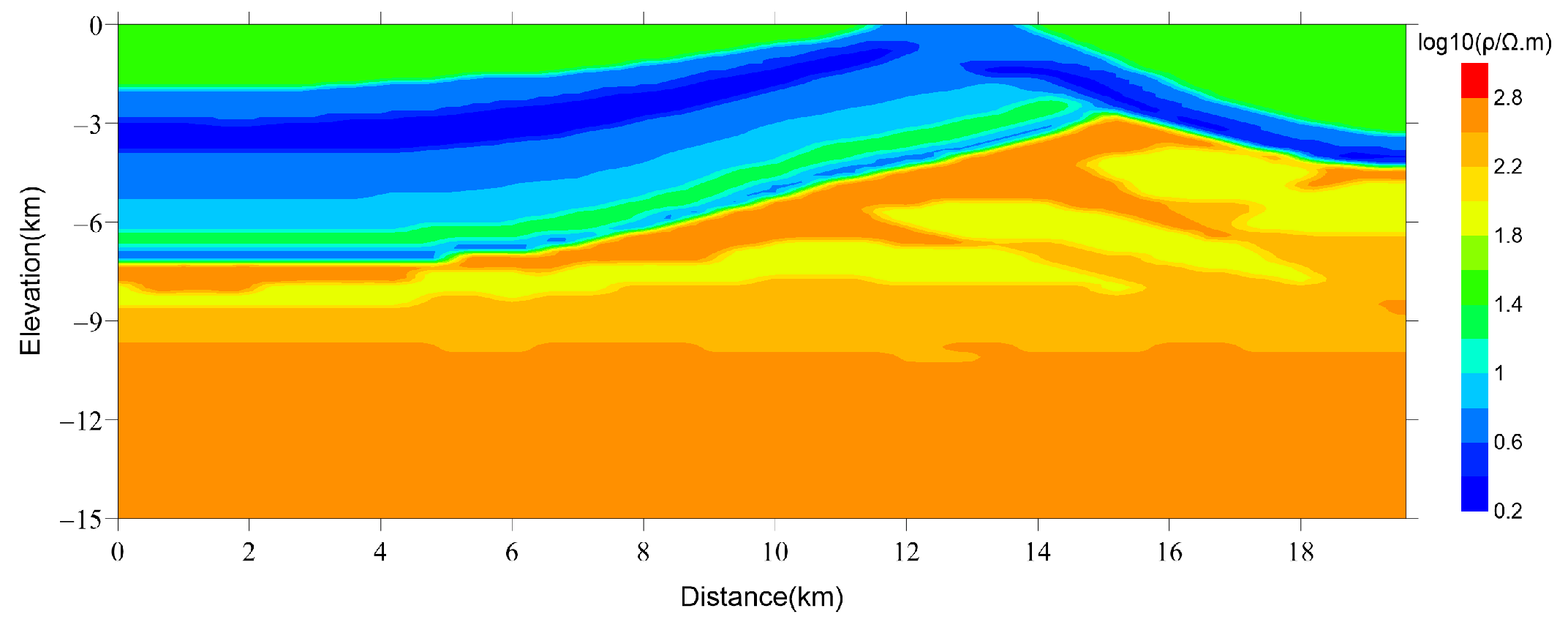
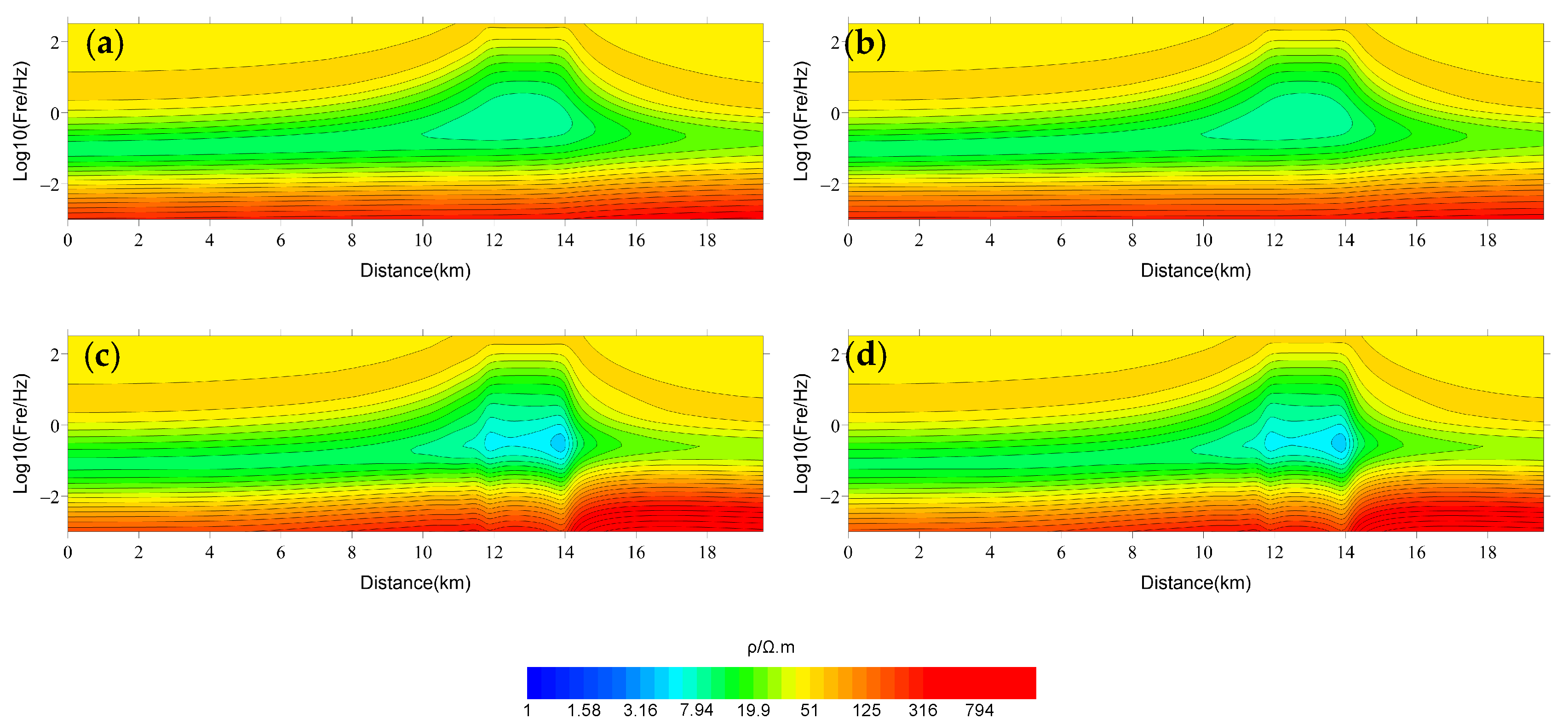

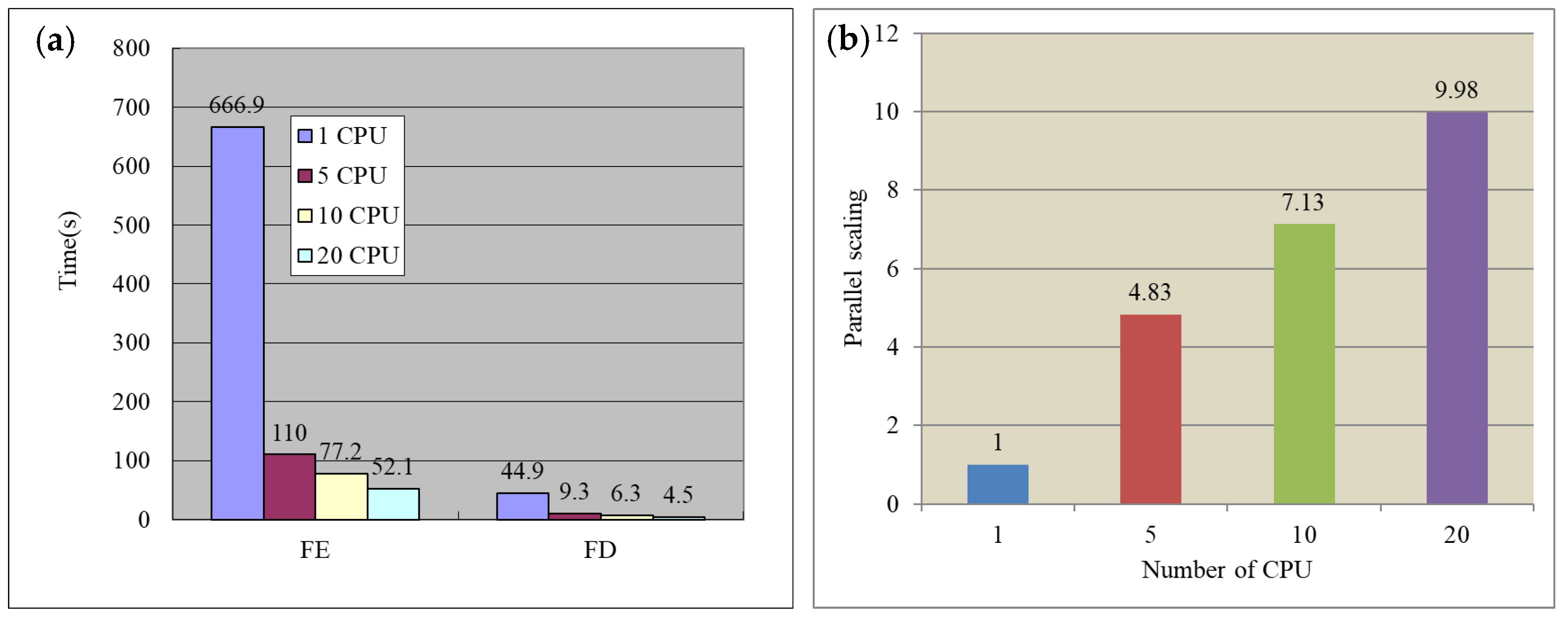
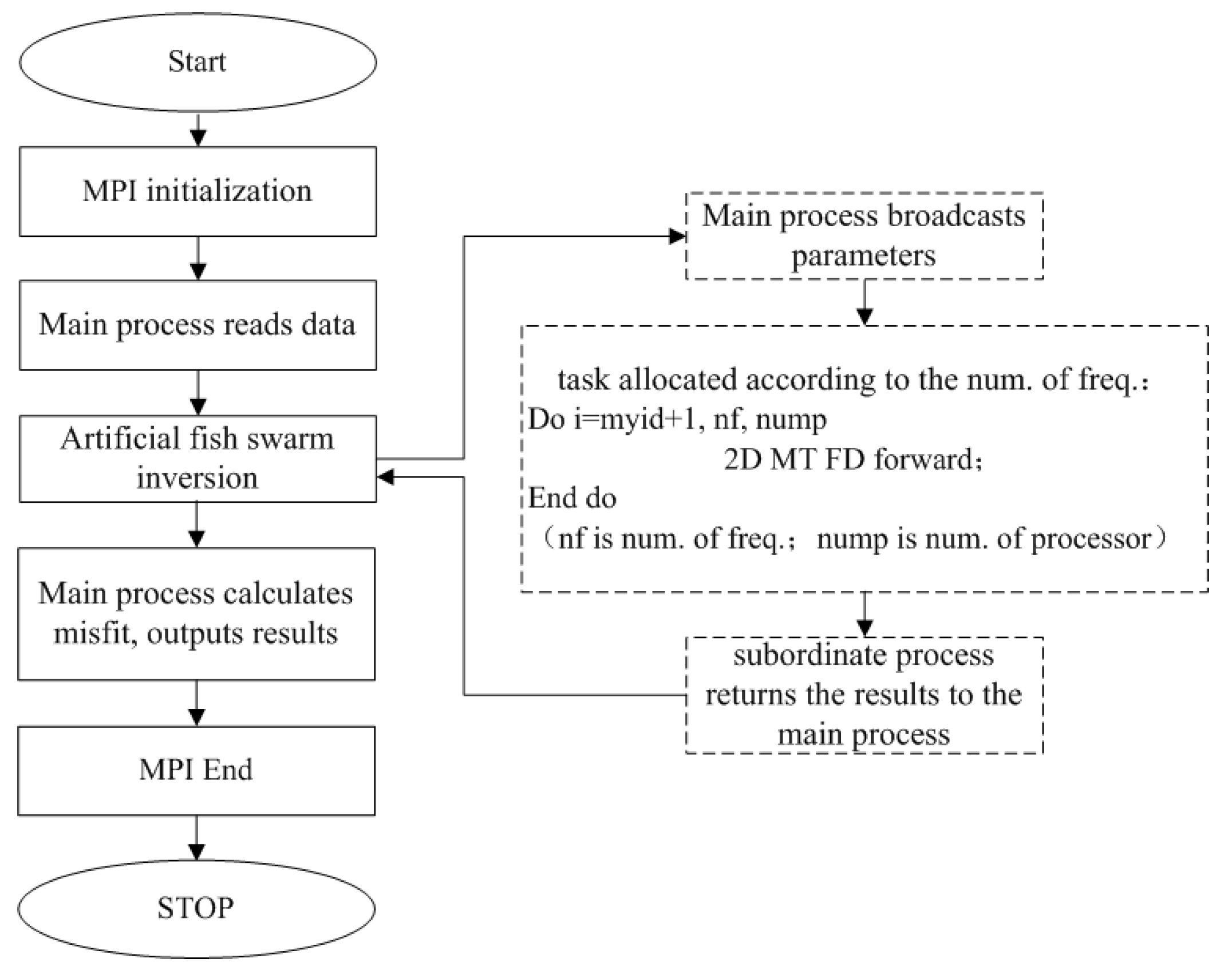
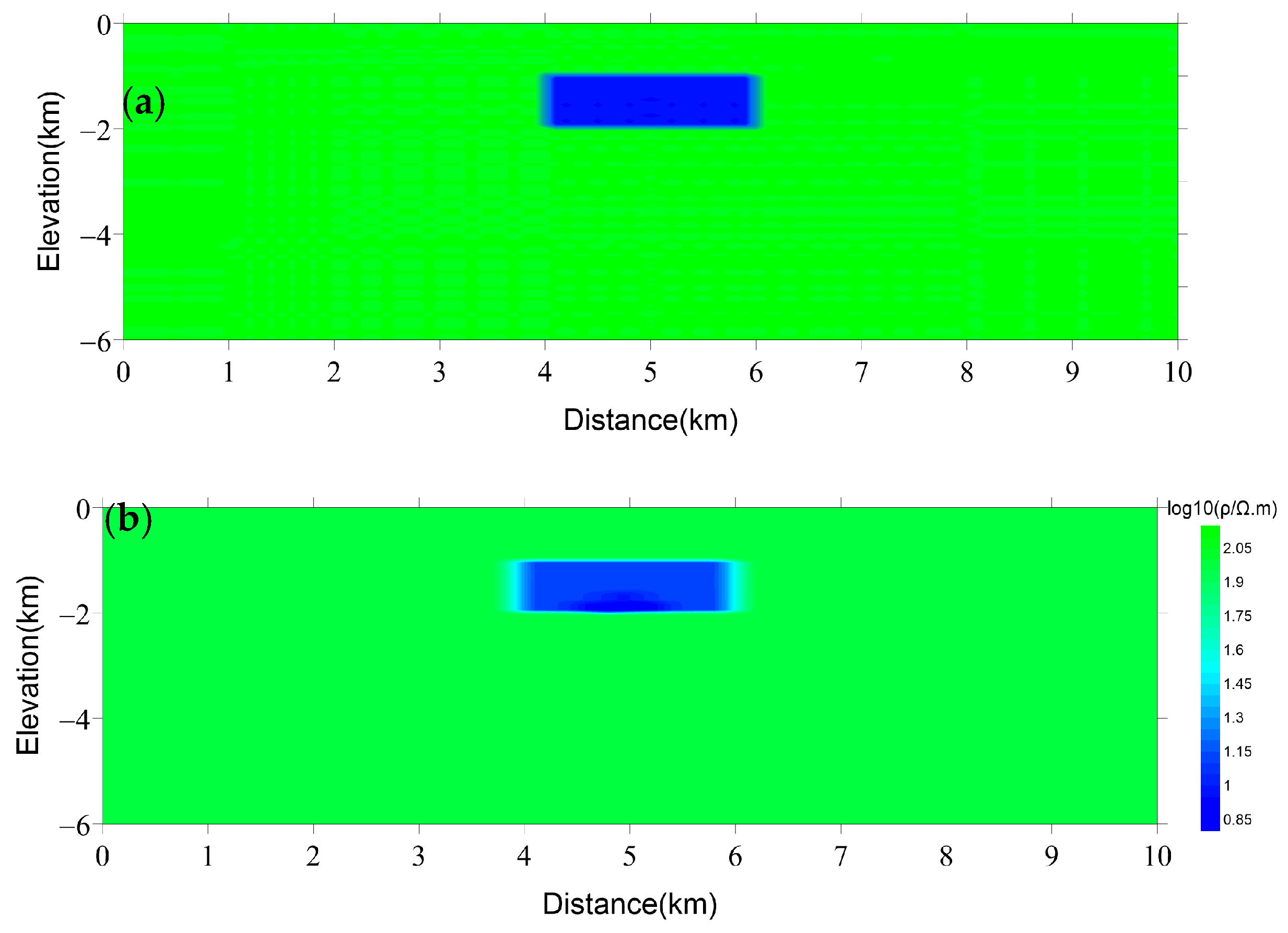
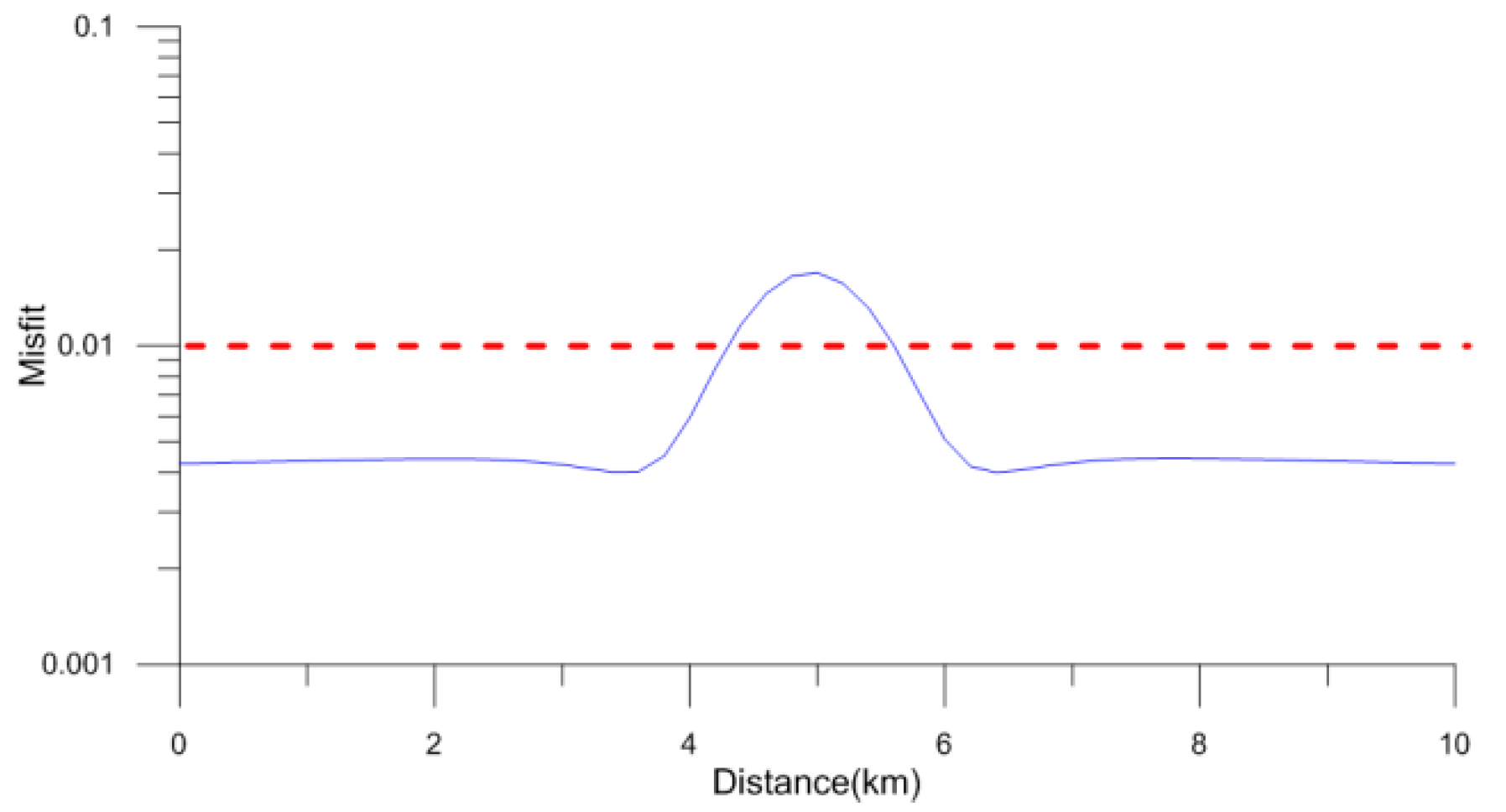

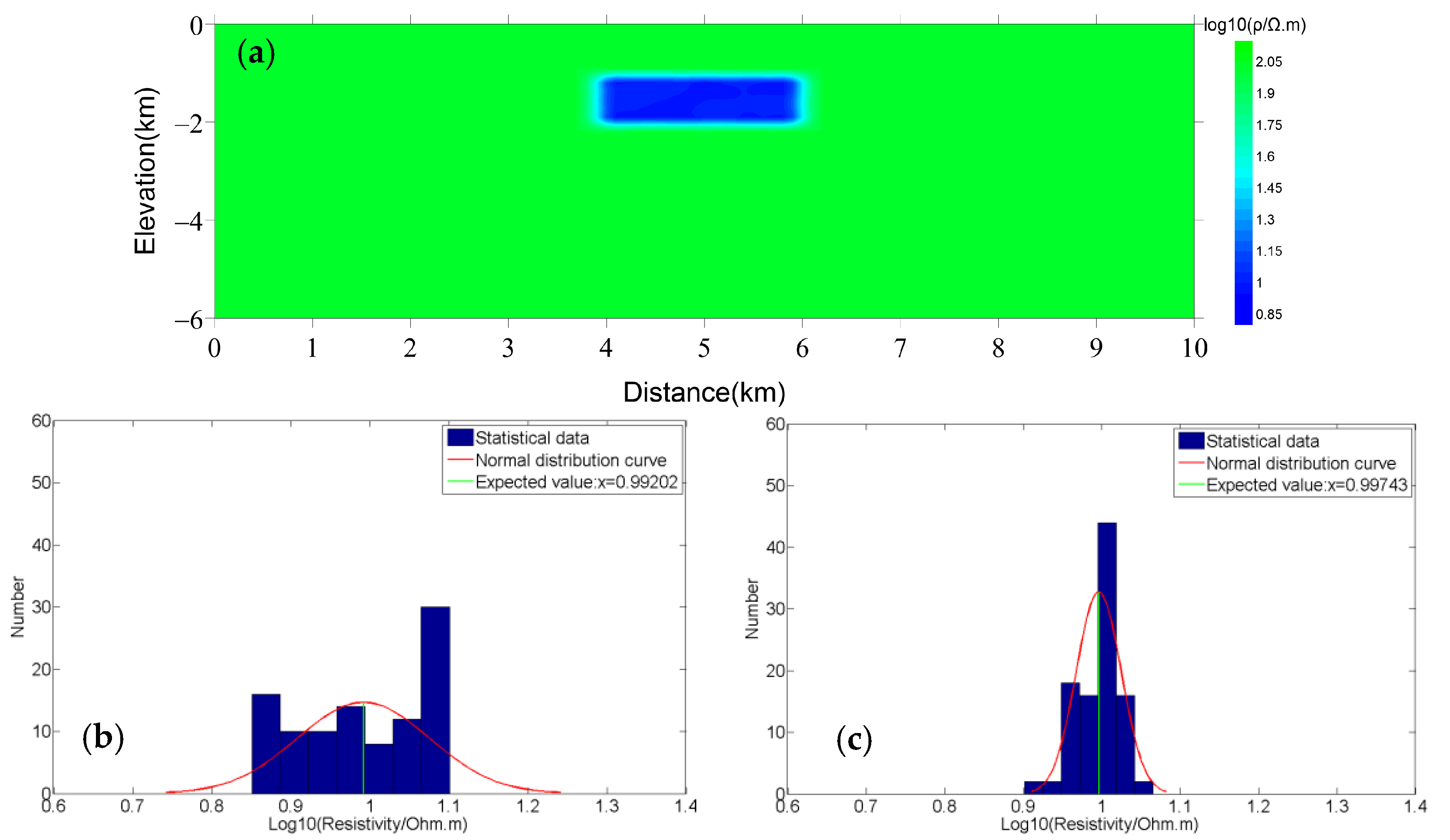
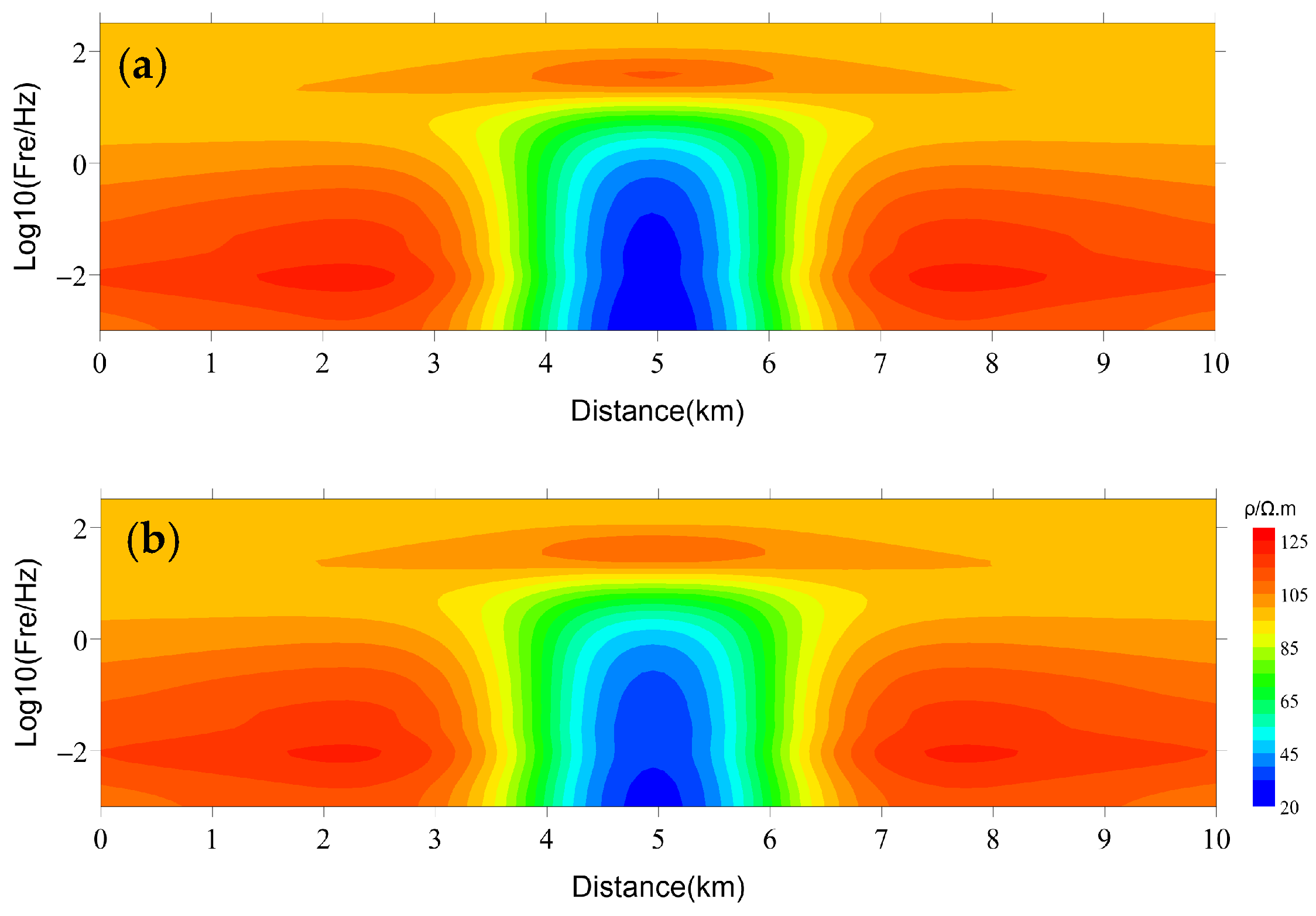
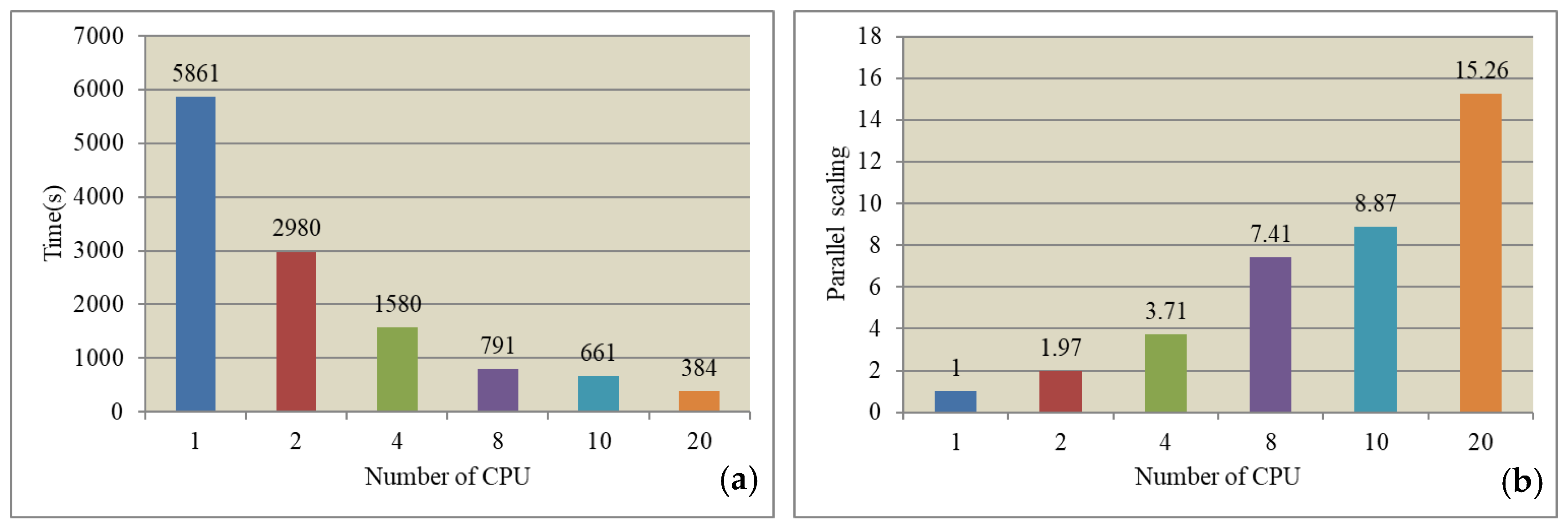
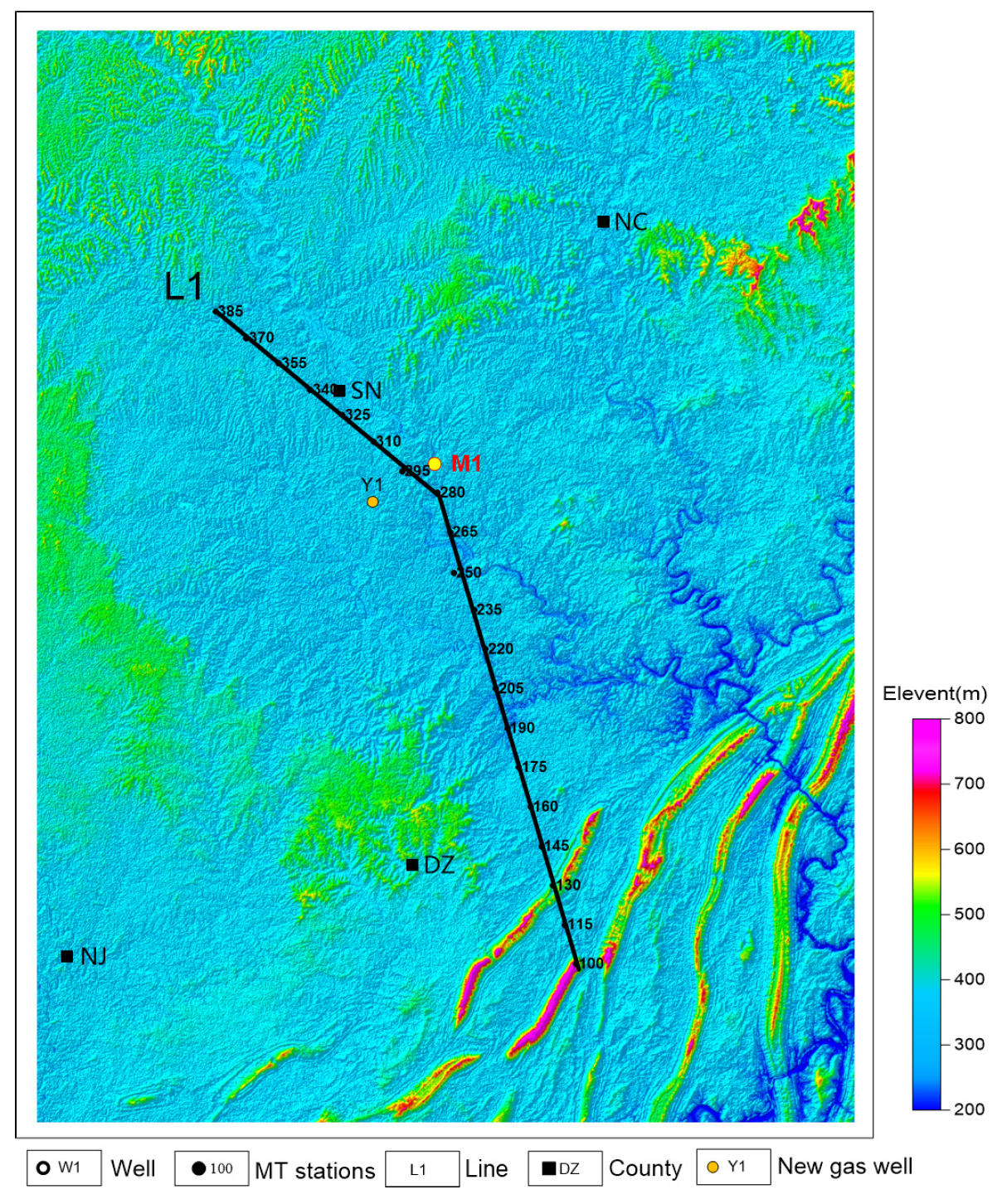
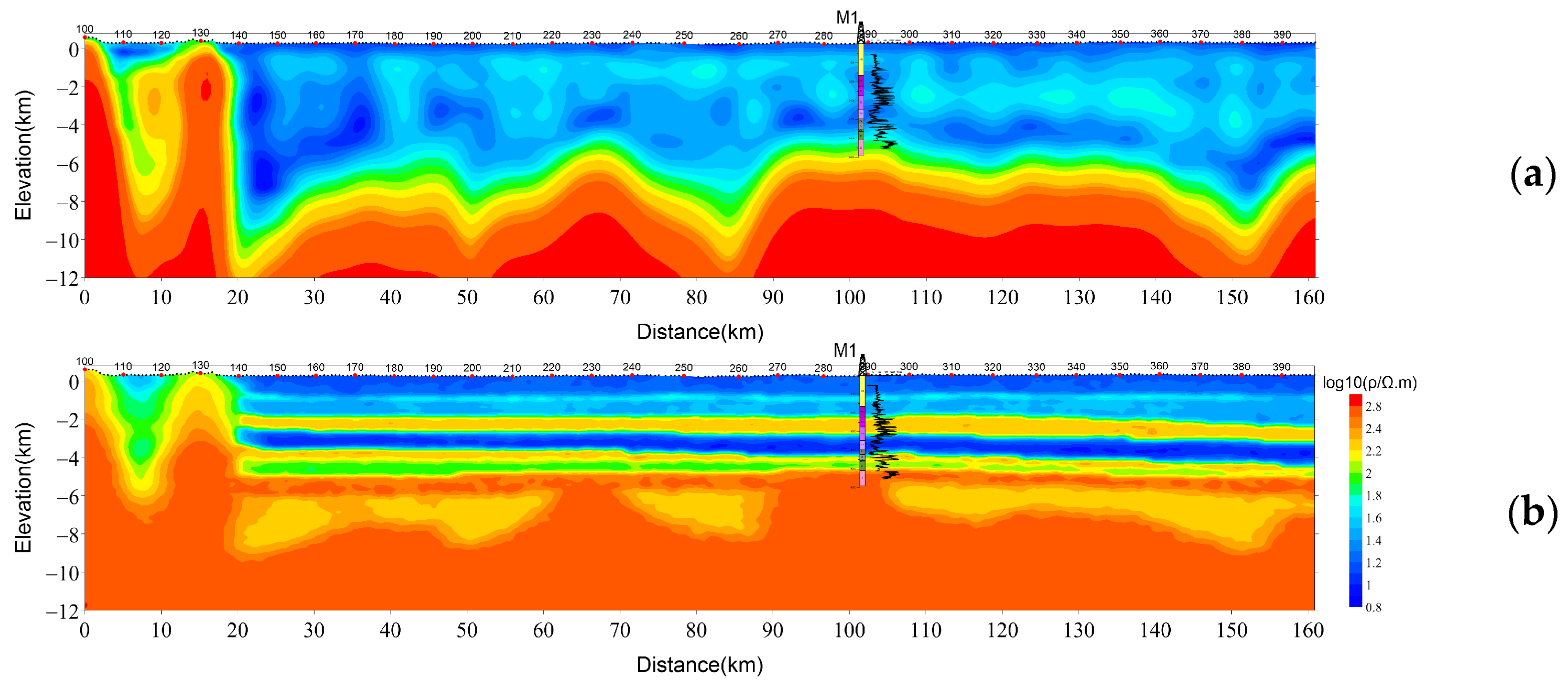
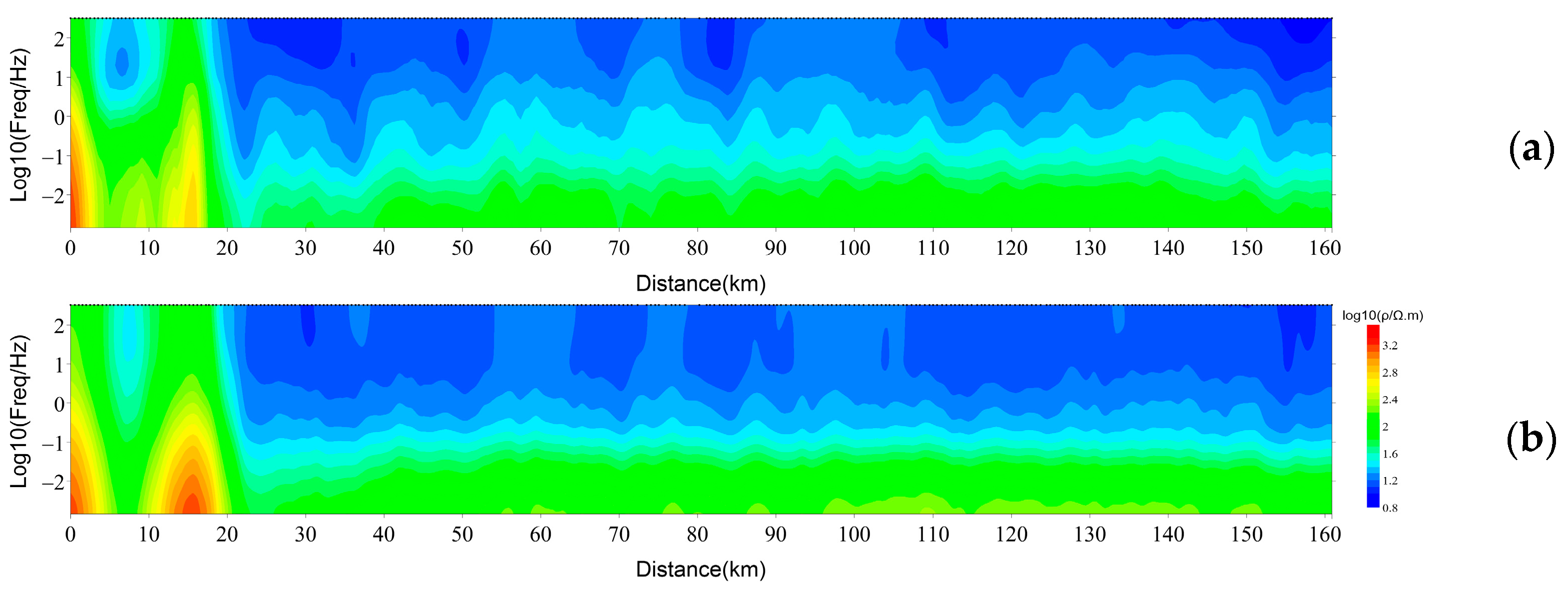
Disclaimer/Publisher’s Note: The statements, opinions and data contained in all publications are solely those of the individual author(s) and contributor(s) and not of MDPI and/or the editor(s). MDPI and/or the editor(s) disclaim responsibility for any injury to people or property resulting from any ideas, methods, instructions or products referred to in the content. |
© 2023 by the authors. Licensee MDPI, Basel, Switzerland. This article is an open access article distributed under the terms and conditions of the Creative Commons Attribution (CC BY) license (https://creativecommons.org/licenses/by/4.0/).
Share and Cite
Hu, Z.; Shi, Y.; Liu, X.; He, Z.; Xu, L.; Mi, X.; Liu, J. Two-Dimensional Magnetotelluric Parallel-Constrained-Inversion Using Artificial-Fish-Swarm Algorithm. Magnetochemistry 2023, 9, 34. https://doi.org/10.3390/magnetochemistry9020034
Hu Z, Shi Y, Liu X, He Z, Xu L, Mi X, Liu J. Two-Dimensional Magnetotelluric Parallel-Constrained-Inversion Using Artificial-Fish-Swarm Algorithm. Magnetochemistry. 2023; 9(2):34. https://doi.org/10.3390/magnetochemistry9020034
Chicago/Turabian StyleHu, Zuzhi, Yanling Shi, Xuejun Liu, Zhanxiang He, Ligui Xu, Xiaoli Mi, and Juan Liu. 2023. "Two-Dimensional Magnetotelluric Parallel-Constrained-Inversion Using Artificial-Fish-Swarm Algorithm" Magnetochemistry 9, no. 2: 34. https://doi.org/10.3390/magnetochemistry9020034
APA StyleHu, Z., Shi, Y., Liu, X., He, Z., Xu, L., Mi, X., & Liu, J. (2023). Two-Dimensional Magnetotelluric Parallel-Constrained-Inversion Using Artificial-Fish-Swarm Algorithm. Magnetochemistry, 9(2), 34. https://doi.org/10.3390/magnetochemistry9020034






